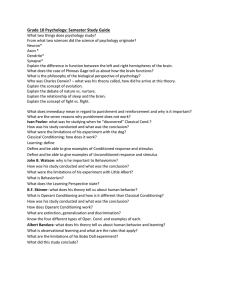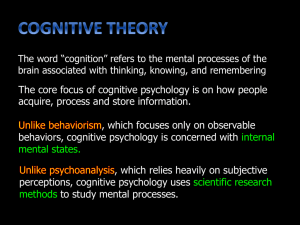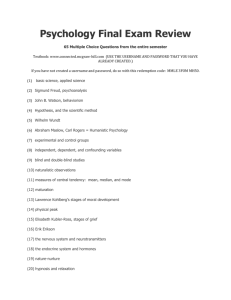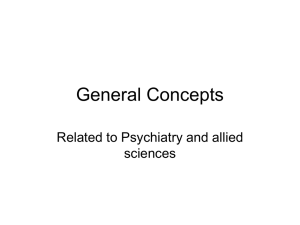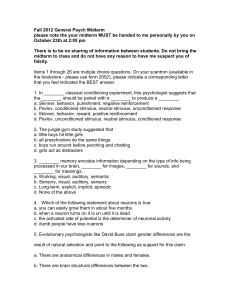Per 7 Year 1 Review
advertisement
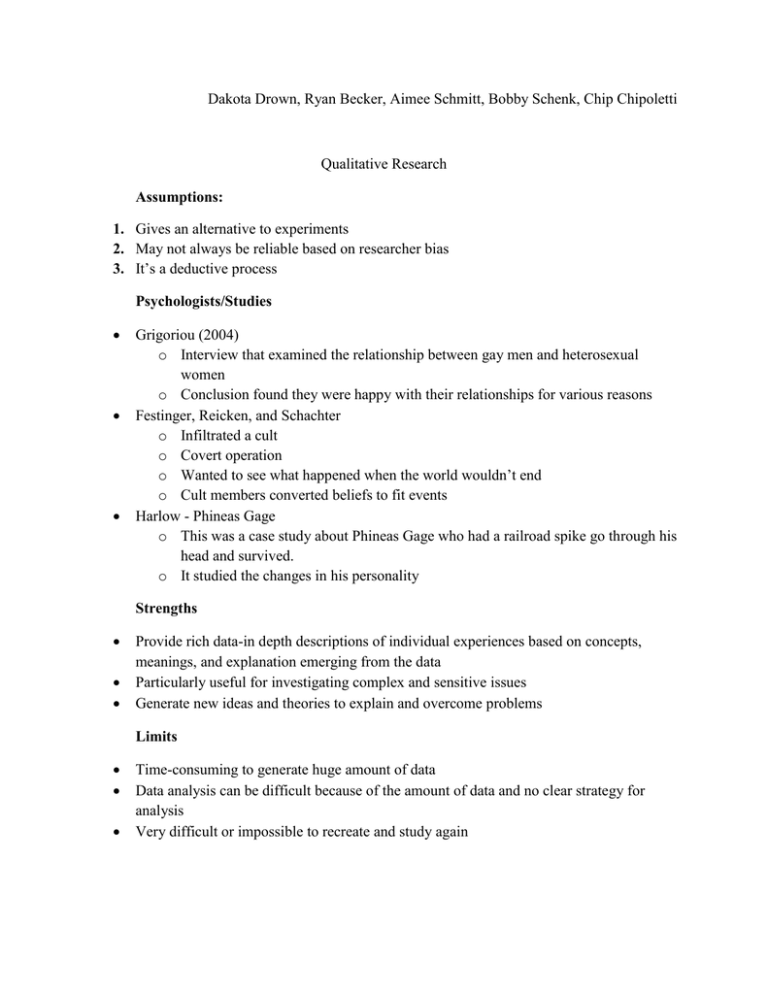
Dakota Drown, Ryan Becker, Aimee Schmitt, Bobby Schenk, Chip Chipoletti Qualitative Research Assumptions: 1. Gives an alternative to experiments 2. May not always be reliable based on researcher bias 3. It’s a deductive process Psychologists/Studies Grigoriou (2004) o Interview that examined the relationship between gay men and heterosexual women o Conclusion found they were happy with their relationships for various reasons Festinger, Reicken, and Schachter o Infiltrated a cult o Covert operation o Wanted to see what happened when the world wouldn’t end o Cult members converted beliefs to fit events Harlow - Phineas Gage o This was a case study about Phineas Gage who had a railroad spike go through his head and survived. o It studied the changes in his personality Strengths Provide rich data-in depth descriptions of individual experiences based on concepts, meanings, and explanation emerging from the data Particularly useful for investigating complex and sensitive issues Generate new ideas and theories to explain and overcome problems Limits Time-consuming to generate huge amount of data Data analysis can be difficult because of the amount of data and no clear strategy for analysis Very difficult or impossible to recreate and study again Applications It’s one of the most efficient ways to find meaningful insight into behaviors that are hard to otherwise study such as cults. It can be used to study rare circumstances such as railroad spikes going through one’s head It can be applied to cases where it would be hard to study the subjects in any other way, the snowball method of gathering participants is a good example of this. Danielle R., Collin L., Tayla K., Carol A., and Daniel D. Period 7 Behavioral Psychology Assumptions: Behaviorism is based on many assumptions. However, there are three very important assumptions associated with behaviorism. The main assumption for behaviorism is that learning occurs through interactions with the environment. In order to learn, we need to perceive events in our environment, and connect those events to our behavior. Also, many psychologists found out that humans learn all their behavioral habits through cultures that they’ve developed overtime. Another assumption based on behaviorism is that the change in behavior of a human is influenced by memories of experience. For example, the harm from most form of stress (work, finances, school, etc.) comes from our own response to it or experiences that shape the way we cope with it. If we experience something bad in our life, we make sure to change the way we act so it doesn’t occur again, and vice versa. The last assumption is that behavior is influenced by its consequences. This has something to do with operant conditioning which is the connection of the emitted behavior and its consequences (reinforcements and punishments). Operant conditioning is useful to reward someone or something, as well to stop bad behaviors. This kind of conditioning is known to be one the fundamental concepts in behavioral psychology. Psychologists/Studies: Ivan Pavlov ● Demonstrated the (classical) conditioning process in dogs. ● Pavlov looked at salivation in dogs in response to being fed. ● Pavlov found that the dogs would salivate whenever the lab assistant entered the room, whether they brought the dogs food or not. ● Neutral Stimulus: The Lab assistant, who eventually became associated with the unconditioned stimulus, the food. ● Unconditioned Stimulus: Food ● Unconditioned Response: Salivate Burrhus Frederic Skinner ● Skinner believed that the best way to understand behavior is to look at the causes of an action and its consequences (Operant Conditioning) ● Skinner studied operant conditioning by conducting experiments using animals which he placed in a Skinner Box. ● Neutral Operants: responses from the environment that neither increase nor decrease the probability of a behavior being repeated ● Reinforcers: Responses from the environment that increase the probability of a behavior being repeated. Reinforcers can be either positive or negative. ● Punishers: Responses from the environment that decrease the likelihood of a behavior being repeated. Punishment weakens behavior. ● (http://www.simplypsychology.org/operant-conditioning.html) John B. Watson ● Little Albert experiment ● Furthered Pavlov’s experiment to show how emotional reactions could be classically conditioned in people. ● Watson exposed the 9 month old baby to stimuli that included a white rat, a rabbit, a monkey, masks and burning newspaper. The boy showed no fear to these objects initially. The second time that Albert was exposed the white rat, Watson made a loud noise by hitting a metal pipe with a hammer. He began to cry after hearing the loud noise. After continuously pairing the white rat with the loud noise, Albert began to cry just seeing the rat. ● Neutral Stimulus: The white rat ● Unconditioned Stimulus: The loud noise ● Unconditioned Response: Fear ● Conditioned Stimulus: The white rat ● Conditioned Response: Fear Strengths: One strength to behavioral psychology is that is has successfully applied to classical and operant conditioning to its theories. Another strength is that all behaviors are observable and are therefore applicable to be studied and analyzed. One last strength in behavioral psychology is that scientific methods of research can be used to determine results and data. Limitations: Psychology is the study of mental processing in our everyday life. This includes critical thinking, physical development and the connection to the brain emotionally and mentally. There are many aspects of the brain that range from cognition, which is critical thinking, to behavior and learning. The behavior aspect of psychology primarily deals with learning process and how the brain adapts to new learned experiences, as well as how the new learned experiences are internalized. Many studies have been conducted in order to understand the brain in depth. These studies have shown the brains adaptation, and sensory. However with these studies does come limitations. The overall limitation of behavioral analysis of the brain include the fact that behaviorism is primarily concerned with observable behavior, as opposed to internal events like thinking and emotion. Observable external behavior can be objectively and scientifically measured. Therefore limitations of behaviorism include internal and external factors. For instance behaviorism ignores mediational processes, which is an emotional/spiritual/internal process, and biological hormones. Environmental settings determine behavior, and can create a low ecological value in studies. With these factors in mind unlike most psychological studies animals cannot be used for studies in the comparison to humans for most behaviorist test. Applications: Behavior patterns observed through the use of psychological methods such as Classical and Operant Conditioning have had massive beneficial applications in real world scenarios. Developed through work done by psychologists such as Pavlov, Watson, and Skinner, Behavioral psychology has shown how important environmental influences can be on behavior such as learning and human development. From Skinner’s 1948 superstition study, we have learned much more about superstition and how using positive and negative reinforcement can be used to affect behavior with ADHD. Other benefits from this area of psychology have resulted from Pavlov's study of conditioning, as new techniques for treating phobias and fears have been developed. The study of behavioral psychology has had a largely beneficial impact on understanding how one’s environment influences behavior and the implications of this impact. IB HL Review: Cognitive Psychology Assumptions Cognitive psychology is defined as studying the structure and functions of the mind. Cognitive psychologists presume that the study of internal mental processes is impertinent to understanding behavior as cognitive processes actively organize and manipulate information. Therefore, it has also led to the assumption that humans are information processers and that the procedures within these systems can be researched and tested scientifically. At the same time, psychologists infer that cognitive processes are influenced by external aspects, such as social and cultural factors. Psychologists/Studies WHAT YOU EXPECT IS WHAT YOU GET, Rosenthal, R., & Jacobson, L. (1966). Teachers’ expectancies: Determinates of pupils’’ IQ gains. Psychological Reports, 19, 115-118. Brief Summary: The researchers of this study hypothesized that expectations of teachers upon their students would affect their intelligence. Results: The children for whom the teachers had expected greater intellectual growth averaged significantly greater improvement than did the control children (12.2 and 8.2 points, respectively.) Two major findings emerged from this early study. First, the expectancy effect previously demonstrated in formal laboratory settings also appears to function in less experimental, real-world situations. Second, the effect was very strong in the early grades, yet almost nonexistent for the older children. THANKS FOR THE MEMORIES!, Loftus, E. F. (1975). Leading questions and the eyewitness report. Cognitive Psychology, 7, 560-572. Brief Summary: The aim of the study was to determine whether or not language can alter memory and whether leading questions could distort eyewitness testimony. There were four experiments performed. Results: Experiment 1: In the group that had been asked about the stop sign, 40 subjects (53 %) said they saw a stop sign for Car A, while only 26 (35 %) in the turned-right group claimed to have seen it. This difference was found to be statistically significant. Experiment 2: The group that had received the question presupposing 12 demonstrators reported seeing an average of 8.85. Those who had received the question asking about 4 demonstrators averaged 6.40. This was also a significant difference. Some of the subjects recalled the correct number of 8. However, this experiment showed that, on average, the wording of one question altered the way subjects remembered the basic characteristics of a witnessed event. Experiment 3: Of those subjects who had previously answered a question in which a barn was mentioned, 13 (17.3%) of them answered Yes to the test question a week later, compared with only 2 (2.7%) in the no-barn group. Once again, this was a statistically significant difference. Experiment 4: Three groups of 50 subjects viewed a three-minute film shot from the inside of a car that ends with the car colliding with a baby carriage pushed by a man. The three groups then received booklets containing questions about the film. These booklets differed as follows: Group D: The direct question group received booklets containing 40 "filler" questions and five key questions directly asking about nonexistent objects; for example, "Did you see a barn in the film?" Group F. The false presupposition group received the same 40 filler questions and five key questions that contained presuppositions about the same nonexistent objects, such as, "Did you see a station wagon parked in front of the barn?" Group C: The control group received only the 40 filler questions. SCHEMA THEORY Anderson and Pichert (1978) Brief Summary: The study sought to prove whether or not schema (mental representation of knowledge) affected retrieval and encoding. Results: The participants in the changed schema group remembered 7% more points on the second recall than the first. Recall of points that were only linked to the new schema increased 10% while recall of points relating to the previous schema decreased. The group that retained their original schema remembered fewer points the second time around. The results show that schema processing must effect retrieval and encoding, because the new schema could’ve only influenced recall during the retrieval stage. People also encoded information which was irrelevant to their prevailing schema, because those in the buyer schema could remember information relating to the burglar schema and vice versa. Strengths Cognitive psychology has many strengths. One of which is that cognitive psychology is very scientific and laboratory based meaning conclusions are more likely to be reliable and recreate-able due to larger amounts data collected. Another strength is that it provides explanations for human behavior as well as practical application. For example, research on flashbulb memory is now used in analysis of a witness’s testimony in court. A third strength is that cognitive psychology works with other areas to produce theories and applications. For example, cognitive and behavioral psychology were used to create the Social Learning theory by Bandura , saying that learning is done through observation and modeling, which includes memory, attention, and motivation. Limitations Many psychologists believe that a major limitation of cognitive psychology is that it perceives human information processing to be over-simplistic. As human functioning is more complex than computer functioning and can be affected by factors such as emotions, it is believed that it shouldn't be treated as such. Another limitation is that it can be unrealistic as the psychology appears to neglect biological factors and commonly assume that the human mind can be reduced down to segregation of functions. Lastly, experiments in cognitive psychology concerning behavior can sometimes be affected by psychologists’ own subjectivity and opinions upon their subjects. Application Cognitive psychology is applicable on the handling of law, education, and emotional memories. In law, the studies conducted by Loftus showed the inaccuracies which can result from inappropriate questioning of witnesses of a case. These studies have changed the methods of questioning to decrease suggestions. In education, the study of the Pygmalion Effect has increased awareness of the great extent to which educators can affect their students. This means that a student's test score does not reflect the student's true intelligence and that certain students may be at a disadvantage from factors other than their own abilities. The importance and responsibilities of the educator is reflected in the study. Finally, the study on flashbulb memory has shown that memories of emotional events are not necessarily correct. So, for example, historical or sociological studies of great events does not reflect the event itself but rather the effect of the event on the population. Assumptions: Behavior is genetically based, as evolution may play a key role in behavior. Animal research can provide insight into human behavior; therefore, a majority of the research includes animals. There are biological correlates of behavior, meaning it should be possible to find a link between a specific biological factor and a specific behavioral factor. Studies: 1. Martinez and Kesner on the role of neurotransmitters in learning and memory (1991). a. Aim of determining the role of the neurotransmitter acetylcholine on memory. b. Acetylcholine is believed to play a role in memory information. c. Used rats in experiment injected with scopolamine and one with physostigime. 2. Phineas gage and Dr. John Harlow a. Metal poles sent through skull (1848) left cheek pierced the base of the skull. b. Lost vision in left eye. c. Balance between his intellectual abilities and his emotional control were destroyed. 3. Minnesota Twin Study- Bouchard a. 1979. b. Mza (twins apart) compared to MST’s (raised together). c. 20% of intelligence can be attributed to genetic inheritance. Strengths: Detailed knowledge of components of human behavior to understand how several factors may interact to cause behaviors. Brain research develops rapidly. Develop an understanding in the role genetics play in behavior. Limitations: Not always ethical enough to conduct studies or experiments on humans, so animals are often used. This causes questions as to how extensively findings can be generalized to humans. The technology necessary is not always readily available, and the use of gamma rays and x-rays can be harmful if overused. Applications: Chemicals in the brain have an effect on behavior. Chemicals can coordinate with different functions in the brain. Memories grow stronger as synapses shrink.

